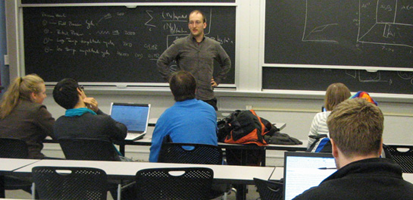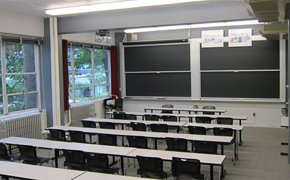Course Overview
This page focuses on the course 22.033/22.33 Nuclear Systems Design Project as it was taught by Dr. Michael Short in Fall 2011.
Nuclear Systems Design Project is an intense capstone project course designed primarily for MIT nuclear engineering undergraduates. In this course, students collectively tackle all facets of an open-ended, multi-disciplinary nuclear engineering design challenge.
Course Outcomes
Course Goals for Students
To learn to work on an open-ended, “no right answer” problem that requires choosing design parameters, optimizing them, and defending a proposed design. Learn more.
Possibilities for Further Study/Careers
- Graduate study in nuclear engineering
- Careers in nuclear engineering

Dr. Short addresses 22.033 students during class.
In the following pages, Dr. Short discusses specific aspects of his experience as the course instructor.
- Developing the project assignment
- Guiding students through each phase of the course
- Tailoring the course to students' needs
- Teaching students to be engineers
- Teaching communication
- Making content tangible
Curriculum Information
Prerequisites
- For undergraduate (22.033) credit: no prerequisites
- For graduate (22.33) credit: 22.312 Engineering of Nuclear Reactors
Requirements Satisfied
Offered
- Every fall

Breakdown by Year
A mix of juniors and seniors. Graduate students may enroll, but none did during the Fall 2011 semester.
Breakdown by Major
All Nuclear Science and Engineering majors.
Typical Student Background
Substantial coursework in Nuclear Science and Engineering.
Ideal Class Size
The ideal class size is between 5 and 20. There is no enrollment cap. As the required capstone class for undergraduate NSE majors, the class size is closely tied to the number of juniors and seniors majoring in NSE in any given year. If enrollment were unusually high in a year, the class would be split into two groups that would simultaneously engage in completely independent design projects. With too many students, communication and collaboration become unwieldy.
During an average week, students were expected to spend 12 hours on the course, roughly divided as follows:
Lecture
- Three class sessions per week, each lasting one hour; 39 sessions total; mandatory attendance
- 9 lecture sessions, 10 recitations, 11 group work sessions, and 9 project presentation sessions
Out of Class
Activities such as
- Background research
- Design
- Writing
- Group meetings
- Individual meetings with the instructor
- Preparation for presentations
Semester Breakdown
| WEEK | M | T | W | Th | F |
|---|---|---|---|---|---|
| 1 |  |
 |
 |
 |
 |
| 2 |  |
 |
 |
 |
 |
| 3 |  |
 |
 |
 |
 |
| 4 |  |
 |
 |
 |
 |
| 5 |  |
 |
 |
 |
 |
| 6 |  |
 |
 |
 |
 |
| 7 |  |
 |
 |
 |
 |
| 8 |  |
 |
 |
 |
 |
| 9 |  |
 |
 |
 |
 |
| 10 |  |
 |
 |
 |
 |
| 11 |  |
 |
 |
 |
 |
| 12 |  |
 |
 |
 |
 |
| 13 |  |
 |
 |
 |
 |
| 14 |  |
 |
 |
 |
 |
| 15 |  |
 |
 |
 |
 |
| 16 |  |
 |
 |
 |
 |
 No classes throughout MIT
No classes throughout MIT Lecture
Lecture Presentation
Presentation Assignment due date
Assignment due date No class session scheduled
No class session scheduled Recitation
Recitation Group work
Group workLead Instructor (Dr. Michael Short)
To design the course project, structure and run the course, work with students, and provide feedback. Read more about Dr. Short’s role in guiding students through each phase of the course.
Teaching Assistant
- To serve as a second instructor, particularly during group work sessions, and to provide and work through examples with students.
- To bring the Gordon Engineering Leadership Program into the course by teaching students about engineering leadership, including how to lead and organize a project, how to work with all different types of people, how to budget time, and how to develop a backup plan.


 Room 1 of 1
Room 1 of 1 